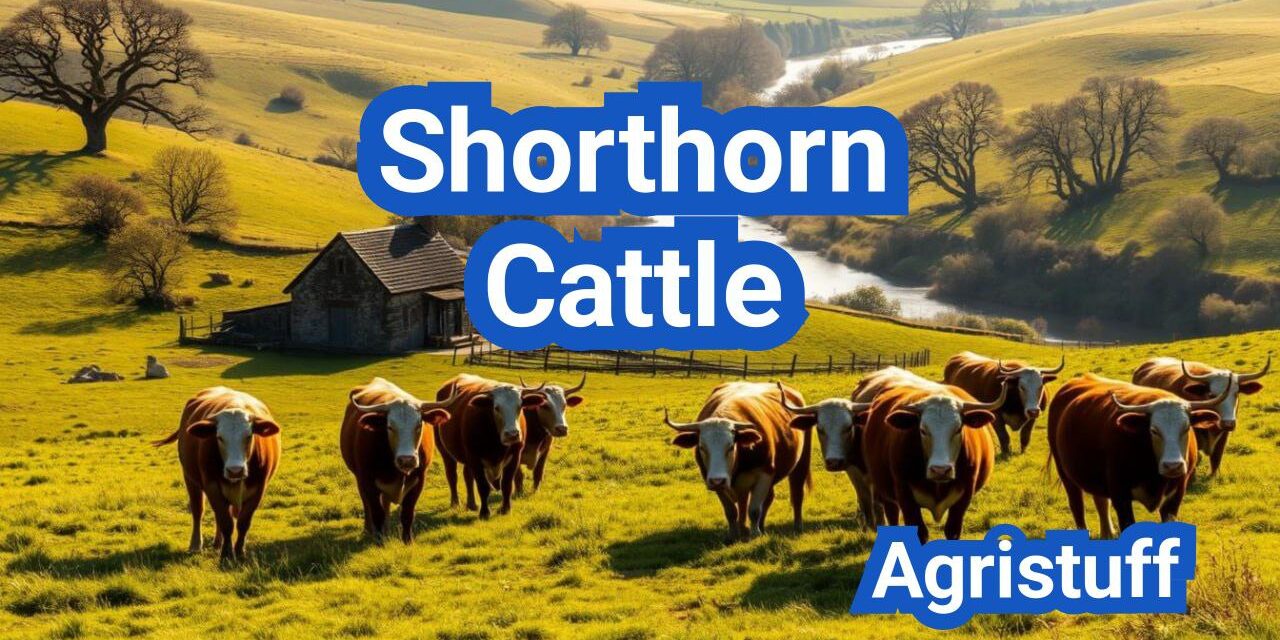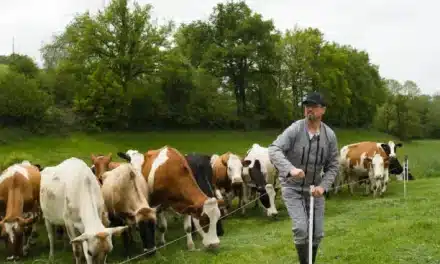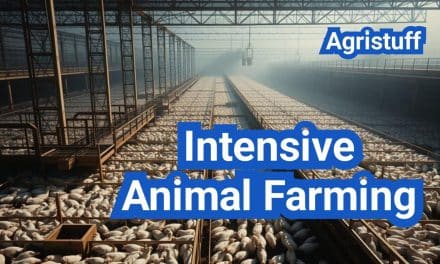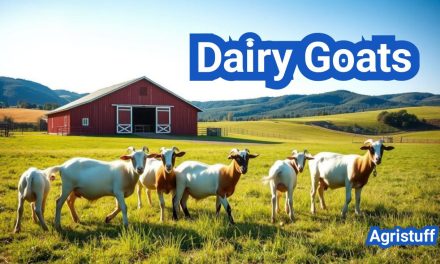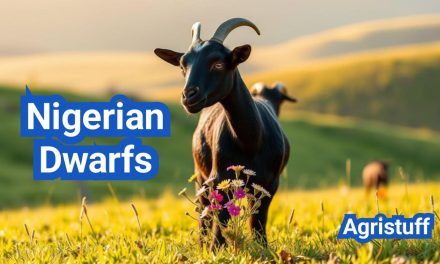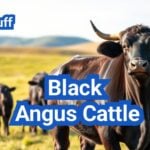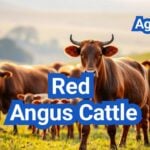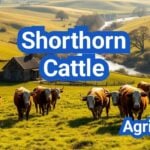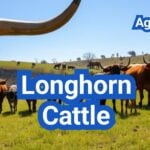The Shorthorn breed has a rich history that dates back to the northeastern counties of England. Developed by influential figures such as Robert Bakewell and the Colling brothers, this breed has become renowned for its versatility and robustness.
The origin of Shorthorn Cattle is deeply rooted in agricultural history, with their development focusing on both beef and milk production. This dual-purpose characteristic has made them a valuable asset to farmers.
Understanding the history, characteristics, and uses of Shorthorn Cattle is essential for appreciating their significance in agriculture. This article will delve into the breed’s background, breeding practices, and various applications.
Key Takeaways
- Shorthorn Cattle originated in northeastern England.
- The breed was developed by pioneers like Robert Bakewell.
- Shorthorn Cattle are known for their dual-purpose use.
- The breed has a significant history in agriculture.
- Breeding practices have evolved to enhance their characteristics.
The Origins of Shorthorn Cattle
The Shorthorn cattle breed has a rich history that dates back to the 16th century in England, where it was developed in the Tees River Valley. This region’s fertile lands and favorable climate made it an ideal place for cattle breeding.
The development of Shorthorn cattle is attributed to the efforts of early breeders, notably the Colling brothers, who played a significant role in shaping the breed’s characteristics. Their work in the 18th century focused on creating a dual-purpose animal, exceling in both beef and milk production.
Early Development in England
In England, the early development of Shorthorn cattle was marked by selective breeding practices aimed at enhancing the breed’s desirable traits. Breeders sought to create cattle that were not only robust and hardy but also capable of producing high-quality beef and milk.
The Tees River Valley, with its rich pastures, provided an ideal environment for the breed to flourish. The Shorthorn’s early popularity can be attributed to its versatility and the economic benefits it offered to farmers.
The Durham Connection
The Shorthorn breed became closely associated with the County of Durham in northeastern England, where it was further developed and refined. The “Durham Shorthorn” became a term synonymous with quality cattle, reflecting the region’s significant contribution to the breed’s development.
The breeders in this region continued the work started by earlier pioneers, further establishing the Shorthorn as a premier cattle breed for both beef and dairy production.
Introduction to North America
Shorthorn cattle were introduced to North America by early settlers who brought with them their breeding stock. The breed quickly gained popularity among American farmers due to its hardiness and productivity.
The establishment of the first beef breed association in the United States for Shorthorn cattle underscored the breed’s importance in American agriculture. It paved the way for the breed’s continued development and adaptation to the American landscape.
Historical Significance and Evolution

The Shorthorn cattle breed has a rich history that spans centuries, significantly influencing modern cattle breeding practices. With its origins in England, the breed has evolved over time, adapting to various agricultural needs and environments.
Impact on Modern Cattle Breeding
The Shorthorn breed has had a profound impact on modern cattle breeding, contributing to the development of numerous other breeds. Its influence can be seen in both beef and dairy cattle, as it has been bred for its hardiness, fertility, and milking ability.
Many modern breeds owe a debt to the Shorthorn, having been cross-bred with Shorthorns to enhance their characteristics. This has led to the creation of breeds that are better suited to specific farming conditions and production needs.
Notable Historical Shorthorn Bloodlines
Throughout history, certain Shorthorn bloodlines have gained prominence for their exceptional qualities. These bloodlines have been carefully bred to enhance desirable traits such as growth rate, fertility, and milk production.
Notable breeders have played a crucial role in shaping these bloodlines, selecting and breeding animals that embody the characteristics they wish to propagate. The result has been a diverse range of Shorthorn types, each with its unique strengths.
Development Through the Centuries
The development of the Shorthorn breed has been a gradual process, spanning centuries. From its early beginnings in England to its spread across the globe, the breed has undergone significant changes in response to changing agricultural practices and market demands.
Today, the Shorthorn breed continues to evolve, with breeders working to improve its characteristics while maintaining its historical integrity. This balance between tradition and innovation ensures the breed remains relevant in modern agriculture.
Understanding Shorthorn Cattle Characteristics
Shorthorn cattle are known for their impressive physical attributes, which have made them a popular choice among farmers and breeders for centuries. Their characteristics play a significant role in their versatility and adaptability.
Size and Weight Specifications
Shorthorn cattle are generally medium to large in size. Mature cows typically weigh between 900 and 1,300 pounds, while bulls can weigh 1,800 pounds or more. Their size and weight make them suitable for various farming operations.
Distinctive Color Patterns
One of the most recognizable features of Shorthorn cattle is their color pattern. They can be found in red, white, and roan variations. Roan Shorthorns display a mix of red and white hairs, giving them a distinctive appearance. The color patterns are not only aesthetically pleasing but also a result of careful breeding practices.
Body Conformation and Structure
The body conformation of Shorthorn cattle is robust and muscular. They have a deep, broad chest and a well-sprung ribcage, contributing to their overall strength and efficiency in both beef and dairy production. Key characteristics include:
- A straight or slightly convex profile
- A muscular hindquarter
- A well-attached udder in females
- A sturdy bone structure
These physical attributes make Shorthorn cattle a valuable asset for farmers looking for a hardy and productive breed.
Behavioral Traits and Temperament

Known for their docility and strong maternal instincts, Shorthorn cattle have become a preferred choice for many cattle breeders. Their temperament is a significant factor in their popularity, as it makes handling and breeding easier and more efficient.
Docility and Handling Ease
Shorthorn cattle are noted for their calm nature, which makes them easy to handle, even for less experienced handlers. This docility is a result of selective breeding that has prioritized temperament alongside other desirable traits.
The ease of handling Shorthorn cattle translates into several practical benefits, including reduced stress for both the animals and the handlers. This calm demeanor is particularly valuable in a farm setting, where safety and efficiency are paramount.
Maternal Instincts and Calving Ease
Shorthorn cows are known for their strong maternal instincts, which contribute to the health and well-being of their calves. These instincts ensure that the cows are attentive to their young, reducing the need for constant supervision.
Additionally, Shorthorn cattle are recognized for their calving ease. This characteristic minimizes the complications during birth, making the breeding process smoother and less risky for both the cow and the calf.
| Trait | Description | Benefit |
|---|---|---|
| Docility | Calm nature | Ease of handling |
| Maternal Instincts | Strong care for calves | Healthier calves |
| Calving Ease | Minimal birth complications | Reduced risk |
Adaptability to Various Environments
Shorthorn cattle are adaptable to a wide range of environments, from grasslands to more intensive farming systems. This adaptability makes them suitable for different climates and management practices.
Their ability to thrive in various conditions is a testament to their robust nature and the result of careful breeding practices that have enhanced their resilience.
Types of Shorthorn Cattle
Shorthorn cattle are categorized into several distinct types, each with its own unique characteristics and purposes. This diversity allows farmers and breeders to choose the type that best suits their needs, whether it’s for beef production, dairy farming, or preserving heritage genetics.
Beef Shorthorn
The Beef Shorthorn is renowned for its fast growth rate and high-quality beef. This type of Shorthorn is specifically bred for its muscular build and marbling ability, making it a popular choice among beef producers. Beef Shorthorns are known for their hardiness and efficiency in converting feed into high-quality meat.
Milking Shorthorn
The Milking Shorthorn is a dual-purpose breed, valued for both its milk production and its ability to produce a viable calf. Milking Shorthorns are known for their rich milk, which is ideal for dairy products. They also have a strong maternal instinct, making them easy to manage in a dairy operation.
Heritage Shorthorn
The Heritage Shorthorn represents the original type of Shorthorn cattle, bred for its hardiness and versatility. Heritage Shorthorns are prized for their genetic diversity and historical significance, making them an important part of agricultural heritage. They are often used in conservation grazing and are valued for their ability to thrive in various environments.
ShorthornPlus
ShorthornPlus cattle are a cross between a purebred Shorthorn and another breed, often used to introduce desirable traits such as improved marbling or increased milk production. ShorthornPlus animals benefit from hybrid vigor, making them a robust choice for farmers looking to enhance their herd’s performance.
In conclusion, the various types of Shorthorn cattle offer a range of benefits and opportunities for farmers and breeders. Whether you’re interested in beef production, dairy farming, or preserving heritage genetics, there’s a type of Shorthorn cattle that can meet your needs.
How to Start Raising Shorthorn Cattle

Raising Shorthorn cattle is a multifaceted endeavor that involves selecting the right animals, preparing appropriate facilities, and ensuring their health and well-being. As a breed known for their hardiness and versatility, Shorthorns can be an excellent choice for both novice and experienced cattle farmers.
Selecting Your First Shorthorns
The first step in starting your Shorthorn cattle operation is selecting high-quality animals that meet your farming goals. Consider factors such as the cattle’s genetic lineage, growth rate, and adaptability to your local climate.
- Research reputable breeders and their cattle’s pedigrees.
- Inspect the health and condition of the animals before purchase.
- Consider the purpose of your operation: beef, dairy, or dual-purpose.
Essential Equipment and Facilities
Adequate equipment and facilities are crucial for the successful management of your Shorthorn cattle. This includes:
| Equipment/Facility | Description |
|---|---|
| Fencing | Robust fencing to secure grazing areas and protect against predators. |
| Watering Systems | Reliable access to clean water is essential for cattle health. |
| Shelter | Adequate shelter to protect cattle from extreme weather conditions. |
| Handling Facilities | Well-designed handling facilities for safe and efficient cattle management. |
As John Smith, a seasoned cattle farmer, once said, “The foundation of a successful cattle operation lies in the quality of its infrastructure and the health of its animals.”
“The right equipment and facilities not only improve the efficiency of your operation but also significantly enhance animal welfare.”
Initial Health Considerations
Ensuring the health of your Shorthorn cattle from the outset is critical. This involves:
- Implementing a comprehensive vaccination program.
- Conducting regular health checks and parasite control measures.
- Providing a nutritious diet tailored to the different life stages of your cattle.
Budgeting for Your Shorthorn Operation
Budgeting is a vital aspect of managing a successful Shorthorn cattle operation. Consider initial start-up costs, ongoing expenses, and potential revenue streams.
- Initial costs include purchasing cattle, equipment, and facilities.
- Ongoing expenses cover feed, veterinary care, and maintenance.
- Potential revenue can come from selling cattle, beef, or dairy products.
By carefully planning and managing these aspects, you can establish a thriving Shorthorn cattle operation that is both profitable and sustainable.
Step-by-Step Shorthorn Cattle Breeding Guide

The process of breeding Shorthorn cattle is multifaceted, involving genetics, trait selection, and strategic planning. Successful breeding programs require a deep understanding of the genetic makeup of Shorthorn cattle and the ability to apply this knowledge effectively.
Understanding Shorthorn Genetics
Shorthorn cattle genetics play a crucial role in determining the characteristics of the breed, including growth rate, fertility, and disease resistance. Genetic diversity is key to a healthy breeding program, as it allows breeders to select for desirable traits while maintaining the overall health and vigor of the herd.
According to the American Shorthorn Association, “Genetic diversity is essential for the long-term sustainability of any cattle breed.” This emphasizes the importance of understanding and managing the genetic pool of your Shorthorn cattle.
Breeding for Specific Traits
Breeding for specific traits involves identifying the characteristics that are most valuable for your operation, such as growth rate, marbling, or milk production. Selection pressure is applied by choosing breeding stock that exhibits these desired traits, thereby increasing their prevalence in the herd over generations.
- Identify key traits for your breeding program
- Select breeding stock based on these traits
- Monitor progress and adjust selection criteria as needed
Crossbreeding Strategies
Crossbreeding can be an effective strategy for introducing new traits into your Shorthorn herd or improving overall performance. By crossing Shorthorns with other breeds, breeders can take advantage of hybrid vigor, resulting in offspring that are more robust and productive than either parent.
A well-planned crossbreeding program can enhance the efficiency and profitability of your cattle operation. It’s essential to research and understand the genetics and characteristics of the breeds involved to achieve the desired outcomes.
Using EPDs in Your Breeding Program
Expected Progeny Differences (EPDs) are a valuable tool in modern cattle breeding, providing breeders with predictions of an animal’s genetic merit for various traits. By using EPDs, Shorthorn breeders can make more informed decisions about which animals to breed, thereby accelerating genetic progress in their herd.
“EPDs have revolutionized the way we approach cattle breeding, allowing us to select for specific traits with greater accuracy and confidence.” – Noted cattle breeder.
To effectively use EPDs, breeders should:
- Understand the EPD values for their breeding stock
- Select animals with EPDs that align with their breeding goals
- Continuously monitor and adjust their breeding program based on EPD data
Nutrition and Feeding Management

Nutrition plays a vital role in the overall performance of Shorthorn cattle. Effective feeding management is crucial for maintaining their health, productivity, and profitability.
Dietary Requirements at Different Life Stages
Shorthorn cattle have different nutritional needs at various stages of their life cycle. For instance, calves require a diet rich in protein and energy to support their rapid growth, while mature cows need a balanced diet that maintains their weight and supports milk production.
Nutritional Needs by Life Stage:
| Life Stage | Nutritional Requirements |
|---|---|
| Calves | High protein, high energy |
| Growing Heifers | Balanced diet with adequate protein and energy |
| Lactating Cows | Increased energy and protein for milk production |
| Mature Bulls | Maintenance diet with quality forage |
Implementing Forage-Based Feeding Systems
Forage-based feeding systems are beneficial for Shorthorn cattle as they promote natural grazing behavior and can be cost-effective. High-quality forage can meet many of the nutritional needs of the cattle.
Supplementation Strategies for Optimal Performance
While forage is a staple, supplementation is often necessary to ensure optimal performance. This can include minerals, vitamins, and concentrates to fill nutritional gaps.
Key Supplementation Strategies:
- Provide free-choice minerals tailored to the forage quality.
- Use concentrates during periods of high demand, such as late pregnancy or early lactation.
- Monitor cattle condition and adjust supplementation accordingly.
Feeding for Grass-Finished Beef Production
Grass-finished beef production is becoming increasingly popular, and Shorthorn cattle are well-suited for this system due to their hardiness and growth rate on grass.
Benefits of Grass-Finished Production:
- Improved fatty acid profile in the beef.
- Potential for higher profit margins due to premium pricing.
- Reduced reliance on grain, which can be cost-effective and environmentally friendly.
Health Management Protocol for S horthorn CattleShorthorn Cattle

Maintaining the health of Shorthorn cattle involves regular checks, vaccinations, and parasite control measures. A comprehensive health management protocol is essential to prevent common health issues and ensure the overall well-being of the herd.
Common Health Issues and Prevention
Shorthorn cattle are generally hardy, but they can be susceptible to certain health issues. Respiratory diseases are a significant concern, particularly in young calves. Implementing a vaccination program can help prevent these issues.
- Respiratory diseases: Vaccination against pathogens such as IBR and BVDV.
- Parasitic infestations: Regular deworming and control measures against ticks and flies.
- Reproductive issues: Monitoring reproductive health and addressing any issues promptly.
Vaccination and Parasite Control Schedule
Developing a vaccination and parasite control schedule is critical for maintaining herd health. This schedule should be tailored to the specific needs of your operation and the prevalent diseases in your area.
| Age | Vaccination | Parasite Control |
|---|---|---|
| Calves (0-6 months) | IBR, BVDV, BRSV | Deworming at 2 and 4 months |
| Yearlings (6-12 months) | Booster shots for IBR, BVDV, BRSV | Regular monitoring and deworming as needed |
| Adults | Annual vaccinations for IBR, BVDV, BRSV | Strategic deworming based on parasite load |
Working with Your Veterinarian
A collaborative relationship with a veterinarian is vital for developing an effective health management protocol. Regular consultations can help identify potential health issues early and ensure that your vaccination and parasite control measures are up-to-date.
Maintaining Herd Health Records
Accurate and detailed herd health records are essential for monitoring the health status of your Shorthorn cattle. These records should include vaccination history, parasite control measures, and any health issues that arise.
By maintaining comprehensive health records, you can make informed decisions about your herd’s health management and identify areas for improvement.
Multiple Uses of Shorthorn Cattle
The multifaceted nature of Shorthorn cattle makes them an ideal choice for various farming operations. Their versatility stems from their robust characteristics, which have been honed over centuries to make them suitable for both beef and dairy production.
Beef Production Benefits
Shorthorn cattle are well-regarded in the beef industry for their excellent growth rates and high-quality beef. They are known for producing well-marbled meat, which is a desirable trait in beef production. The breed’s ability to thrive in various environments and its hardiness make it a popular choice among beef producers.
Their docile nature also makes handling easier, reducing the labor required for managing the herd. Furthermore, Shorthorn cattle are known for their efficient feed conversion, which can lead to cost savings in beef production operations.
Dairy Production Advantages
In addition to their beef production qualities, Shorthorn cattle have historically been used for dairy production. The Milking Shorthorn, a subtype of the breed, is particularly noted for its milk production capabilities. They offer a balance between milk quantity and quality, making them a valuable asset for dairy farmers.
Their milk is rich in protein and butterfat, making it ideal for cheese production and other dairy products. Moreover, the hardiness and fertility of Milking Shorthorns contribute to their appeal in dairy operations, as they can maintain high production levels over their lifespan.
Maximizing Dual-Purpose Potential
The dual-purpose potential of Shorthorn cattle is one of their most significant advantages. Farmers can raise them for both beef and dairy, providing a diversified income stream. This flexibility is particularly valuable in changing market conditions, as it allows farmers to adapt their production to meet demand.
To maximize their dual-purpose potential, farmers should focus on breeding strategies that enhance both beef and dairy traits. This might involve selecting for cattle that exhibit strong characteristics in both areas, such as high milk production and rapid growth rates.
Shorthorn Cattle Organizations and Resources
Breeders of Shorthorn cattle can leverage numerous organizations and digital resources to enhance their operations. These organizations provide a wealth of information, support, and networking opportunities that are crucial for the success of breeding programs.
American Shorthorn Association
The American Shorthorn Association is one of the primary breed associations for Shorthorn cattle in the United States. It offers a range of services including breed registration, breed information, and promotional activities to support breeders.
Key Services:
- Breed registration and pedigree verification
- Breeding program guidance and support
- Promotional activities to enhance breed visibility
Shorthorn Cattle Society
The Shorthorn Cattle Society, based in the UK, is another significant organization for Shorthorn breeders globally. It provides similar services to the American Shorthorn Association, with a focus on the UK and international breeders.
Notable Initiatives:
- Registration and certification of Shorthorn cattle
- Organization of breed shows and events
- Publication of breed-related materials and news
Heritage Shorthorn Society
The Heritage Shorthorn Society is dedicated to preserving and promoting the heritage aspects of Shorthorn cattle. It offers resources for breeders interested in maintaining the historical integrity of their breeding programs.
Resources Available:
- Guidance on heritage breeding practices
- Access to historical breed information and records
- Networking opportunities with other heritage breeders
Digital Resources for Breeders
In addition to breed associations, digital resources play a crucial role in supporting Shorthorn cattle breeders. Online forums, breed databases, and social media groups provide platforms for information exchange and community building.
Popular Digital Platforms:
- Online forums dedicated to Shorthorn cattle breeding
- Social media groups for breeders to share information and experiences
- Breed databases for accessing pedigree information and breeding records
Marketing and Showing Your Shorthorn Cattle
Marketing Shorthorn cattle effectively involves understanding the target audience and showcasing the breed’s unique qualities. Whether you’re a seasoned breeder or just starting out, presenting your cattle in the best possible light is crucial for success in both sales and shows.
Preparing Cattle for Shows and Sales
Preparing your Shorthorn cattle for shows and sales requires attention to detail and a focus on showcasing their best features. Start by ensuring your animals are in top condition through proper nutrition and health management. Regular grooming is also essential, including clipping, washing, and conditioning their coats to highlight their breed characteristics.
Key Preparation Steps:
- Develop a nutrition plan that enhances the animal’s growth and condition.
- Implement a regular health check and vaccination schedule.
- Practice handling and grooming to reduce stress and improve presentation.
Effective Marketing Strategies for Breeders
Effective marketing for Shorthorn breeders involves a mix of traditional and digital strategies. Utilize social media platforms to showcase your cattle through high-quality photos and videos. Attend cattle shows and events to network with potential buyers and promote your brand.
Digital Marketing Tips:
- Create a professional website to showcase your cattle and breeding program.
- Engage with online communities and forums related to cattle breeding.
- Use targeted online advertising to reach potential buyers.
Value-Added Programs and Certification
Participating in value-added programs and obtaining relevant certifications can significantly enhance the marketability of your Shorthorn cattle. Programs such as breed-specific certification can increase buyer confidence and potentially command higher prices.
| Program/Certification | Benefits |
|---|---|
| Breed Association Certification | Increased credibility, higher market value |
| Quality Assurance Programs | Enhanced buyer trust, premium pricing |
| Genetic Testing and Verification | Proven genetics, improved breeding decisions |
Building Your Shorthorn Brand
Building a strong brand is crucial for long-term success in the cattle breeding industry. Focus on developing a recognizable identity that reflects the quality and uniqueness of your Shorthorn cattle. Consistent branding across all marketing materials and online platforms can help establish your reputation.
By implementing these strategies, Shorthorn breeders can effectively market and show their cattle, enhancing their visibility and value in the market.
At The End of: Shorthorn Cattle In The U.S.
Shorthorn cattle are a versatile breed with a rich history, offering multiple benefits to farmers and ranchers. Throughout this article, we have explored their origins, characteristics, breeding practices, and various uses, including beef and dairy production.
The breed’s adaptability, docility, and maternal instincts make them an attractive choice for many producers. By understanding the history and characteristics of Shorthorn cattle, breeders can make informed decisions about their operations and capitalize on the breed’s potential.
In summary, Shorthorn cattle are a valuable resource for the livestock industry, providing a range of opportunities for producers. As we conclude this overview, it is clear that Shorthorn cattle will continue to play a significant role in shaping the future of agriculture.
FAQ
What is the origin of Shorthorn cattle?
Shorthorn cattle originated in England, specifically in the Teeswater region, where they were bred for their dual-purpose capabilities, providing both high-quality beef and milk.
What are the main characteristics of Shorthorn cattle?
Shorthorn cattle are known for their docility, ease of handling, and maternal instincts. They come in various colors, including red, white, and roan, and are medium to large in size, with mature cows weighing between 900-1,300 pounds.
What are the different types of Shorthorn cattle?
There are several types of Shorthorn cattle, including Beef Shorthorn, Milking Shorthorn, Heritage Shorthorn, and ShorthornPlus, each with specific characteristics and uses.
How do I start raising Shorthorn cattle?
To start raising Shorthorn cattle, you should select high-quality animals, invest in essential equipment and facilities, consider initial health needs, and create a budget for your operation.
What are the nutritional requirements of Shorthorn cattle?
Shorthorn cattle require a balanced diet that includes high-quality forage and supplementation as needed, with nutritional needs varying at different life stages.
How do I manage the health of my Shorthorn cattle?
To manage the health of your Shorthorn cattle, you should implement a vaccination and parasite control schedule, work with a veterinarian, and maintain accurate health records.
What are the benefits of raising Shorthorn cattle for beef production?
Shorthorn cattle are known for their high-quality beef, with benefits including marbling, tenderness, and flavor, making them a popular choice for beef production.
Can Shorthorn cattle be used for dairy production?
Yes, Milking Shorthorn cattle are a dual-purpose breed, providing both high-quality milk and beef, making them a versatile choice for dairy farmers.
What resources are available for Shorthorn cattle breeders?
Shorthorn cattle breeders can access various resources, including breed associations, such as the American Shorthorn Association, and digital resources, like Digital Beef.
How can I market my Shorthorn cattle?
To market your Shorthorn cattle, you can prepare them for shows and sales, develop effective marketing strategies, and consider value-added programs and certification.
What is the Cow Productivity Index (CPI), and how is it used in Shorthorn cattle breeding?
The Cow Productivity Index (CPI) is a selection tool used to evaluate the productivity of Shorthorn cattle, helping breeders make informed decisions about their breeding program.
How do I use EPDs in my Shorthorn cattle breeding program?
Expected Progeny Differences (EPDs) are a valuable tool in Shorthorn cattle breeding, allowing breeders to predict the genetic potential of their animals for specific traits.
Conclusion of: Shorthorn Cattle In USA
Introduction: why Shorthorn Cattle still matter in the U.S.
Shorthorn Cattle are a versatile British breed that became a foundation of American beef and dairy herds, prized for docility, maternal strength, and adaptability from humid Southeast pastures to the Great Plains. American Shorthorn Association
Shorthorn Cattle in one minute
In brief, Shorthorn Cattle originated in northern England, spread globally as a dual-purpose breed, and later specialized into beef and milking lines; today U.S. producers value Shorthorn Cattle for calm temperaments, efficient gain, and reliable cows that raise vigorous calves. Oklahoma State University – Breeds of Livestock: Shorthorn
History & origin: from Teeswater/Durham to “Shorthorn Cattle”
The story of Shorthorn Cattle begins in the Tees River valley of northeast England, where Teeswater and Durham cattle were improved by selective breeders in the late 18th century, setting the type that would later be known worldwide as Shorthorn Cattle. Beef Shorthorn Society (UK) – History
Across the Atlantic: early U.S. imports and expansion
Shorthorn Cattle reached America around 1783 and were used extensively by settlers for meat, milk, and work, with Texas adoption following in the 1850s as ranchers crossed Shorthorn Cattle with local stock to improve size and carcass quality. Texas State Historical Association – Handbook of Texas
America’s breed registry and early organization
As Shorthorn Cattle multiplied in the U.S., breeders organized pedigree records, culminating in the establishment of the American Shorthorn Association in 1872, a body that still stewards the herdbook and genetic evaluation for Shorthorn Cattle today. American Shorthorn Association – History
Beef, Dairy, and “Heritage”: understanding today’s strains
Modern Shorthorn Cattle exist as beef-selected lines (Beef Shorthorn), dairy-selected lines (Milking Shorthorn), and “Heritage/Native” Shorthorn that trace closely to early herd books, giving U.S. producers options to match Shorthorn Cattle genetics to specific goals. The Livestock Conservancy – Heritage Shorthorn
Milking Shorthorn: the dairy branch of Shorthorn Cattle
Milking Shorthorn are renowned for productive lactations, efficient feed conversion, and longevity, characteristics that make Shorthorn Cattle a practical fit for moderate-input, pasture-based dairy systems as well as diversified family farms. American Milking Shorthorn Society – The Breed
Breed colors & appearance
Typical coat colors in Shorthorn Cattle are red, white, or roan (a close mix of red and white), with both horned and polled individuals; these visual hallmarks remain standard across beef and dairy strains of Shorthorn Cattle. Beef Shorthorn Society (UK) – Breed Characteristics
Frame, function, and type
Beef-selected Shorthorn Cattle tend to be medium-framed but well-muscled with easy fleshing, while Heritage and dairy strains hold more dual-purpose conformation—anatomy that reflects centuries of selection for practical, profitable Shorthorn Cattle. Shorthorn Society UK – The Breed
Temperament & handling advantages
Docility is a signature advantage of Shorthorn Cattle, supporting low-stress handling, safer working environments, and calmer calves that start fast; many U.S. operators consider this a key reason to add Shorthorn Cattle influence to commercial herds. Canadian Shorthorn Association – The Shorthorn Advantage
Maternal strength & the cow you can build a herd around
U.S. ranchers value Shorthorn Cattle cows for fertility, milk, and mothering ability, delivering heavy, uniform calves while maintaining condition on forage—traits that keep Shorthorn Cattle central to maternal crossbreeding programs. Beef Shorthorn Society (UK) – The Sustainable Suckler Cow
Beef quality, marbling, and feed efficiency
On the beef side, Shorthorn Cattle are competitive for carcass quality, with strong marbling and efficient gain in feedlot or pasture-finishing settings—advantages that complement the maternal reputation of Shorthorn Cattle. Canadian Shorthorn Association – The Shorthorn Advantage
Dairy performance and practical milk
For dairies and grazers, Milking Shorthorn Cattle offer moderate milk with sound components, fertility, and longevity that reduce replacement pressure—helping Shorthorn Cattle fit into low-cost, forage-forward business models. Oklahoma State University – Milking Shorthorn
Where Shorthorn Cattle fit best in the U.S.
Because of their adaptability, Shorthorn Cattle fit cow-calf herds in the Midwest and Plains, rotational grazing in the Southeast, and intensive forage systems in the Northeast and Upper Midwest, giving U.S. producers a flexible genetic tool. American Shorthorn Association
Breeding tools: EPDs and selection indexes for Shorthorn Cattle
Modern genetic evaluation helps U.S. breeders stack the right traits in Shorthorn Cattle, using EPDs and selection indexes to balance calving ease, growth, carcass, and maternal performance for specific ranch goals. Penn State Extension – Understanding EPDs & Genomics
IGS multi-breed evaluation: apples-to-apples context
Shorthorn Cattle participate in International Genetic Solutions (IGS), the largest multi-breed beef evaluation, which lets buyers compare EPDs across breeds on a common base and make data-driven Shorthorn Cattle selections. International Genetic Solutions (IGS)
ASA updates to indexes: stay current as Shorthorn Cattle evolve
The American Shorthorn Association regularly updates evaluation methods and indexes such as the Cow Productivity Index (CPI), keeping Shorthorn Cattle selection tools aligned with commercial realities and replacement-heifer objectives. ASA – Cow Productivity Index Update
Crossbreeding with Shorthorn Cattle
In crossbreeding, Shorthorn Cattle inject maternal heterosis, milk, and docility into British and Continental composites, while maintaining carcass quality—an approach many commercial U.S. producers use to stabilize cow herds with Shorthorn Cattle influence. Beef Shorthorn Society (UK) – Sustainable Suckler Cow
“ShorthornPlus”: recognized composites
U.S. shows and registry rules recognize ShorthornPlus animals that meet documented Shorthorn breed-percentage thresholds, reflecting how Shorthorn Cattle genetics are actively used in structured composites for show and commercial use. ASA – NJSS Rules (ShorthornPlus thresholds)
Color standards and registration basics
Breed societies maintain color standards—red, white, or roan—and registration requirements to preserve integrity of Shorthorn Cattle records, which protects buyers and sellers across the beef seedstock and Milking Shorthorn sectors. Beef Shorthorn Society – Rules & Regulations
Management tips for U.S. cow-calf operations using Shorthorn Cattle
Focus on forage quality, mineral balance, and heifer development targets that match your environment, then select Shorthorn Cattle sires with balanced EPDs for calving ease, growth, and maternal traits to keep replacement pipelines strong. Beef Improvement Federation – Guidelines
Selecting sires and replacement females
When picking Shorthorn Cattle bulls, look past phenotype to genomic-enhanced EPD accuracy and index fit for your program; then retain daughters from the most productive Shorthorn Cattle cows to steadily lift herd profitability. Penn State Extension – Understanding EPDs & Genomics
Health, welfare, and longevity
Docile Shorthorn Cattle are easier to handle, which reduces stress, supports better daily gain and reproduction, and contributes to longevity—one reason many family operations prefer Shorthorn Cattle for multi-year reliability. Canadian Shorthorn Association – The Shorthorn Advantage
Marketing Shorthorn Cattle and beef in the U.S.
Whether you sell feeder calves, freezer beef, or seedstock, clearly signaling Shorthorn Cattle genetics, marbling potential, and docility can differentiate your brand, while registry documentation builds buyer confidence. American Shorthorn Association
Where to learn more & find cattle
For herdbook lookups, sales, and shows, the American Shorthorn Association is your primary U.S. hub, while Beef Shorthorn and Milking Shorthorn societies offer additional resources to optimize Shorthorn Cattle in your operation. American Milking Shorthorn Society – Start Here
Final thought
From homestead dairies to commercial cow-calf ranges, Shorthorn Cattle offer a rare blend of calm temperaments, maternal strength, and beef quality; if you want cattle that work for your land and business, put Shorthorn Cattle on your short list. Oklahoma State University – Breed Overview
Sources & References
- American Shorthorn Association – History
- American Shorthorn Association – Home
- Texas State Historical Association – Shorthorn Cattle
- OSU – Shorthorn (beef) | OSU – Milking Shorthorn
- Beef Shorthorn Society – History
- Beef Shorthorn Society – Characteristics
- Shorthorn Society UK – The Breed
- American Milking Shorthorn Society – The Breed
- The Livestock Conservancy – Heritage Shorthorn
- International Genetic Solutions (IGS)
- Penn State Extension – EPDs & Genomics
- ASA – Cow Productivity Index Update
- Beef Shorthorn – Sustainable Suckler Cow
- Beef Shorthorn – Rules & Regulations (color standard)
- Beef Improvement Federation – Guidelines
- ASA – NJSS Rules (ShorthornPlus thresholds)

